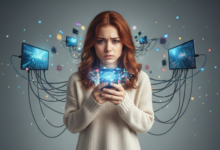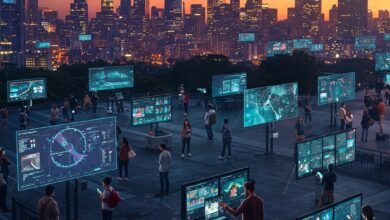Doomscrolling, Anxiety, and TikTok Trends: How Social Media is Rewiring Our Brains

Introduction to Doomscrolling
Doomscrolling, a term that has gained prominence in recent years, refers to the habit of compulsively consuming a large volume of negative news and content on social media platforms. This behavior has emerged as a typical response to a stream of distressing news, particularly during periods marked by global crises, social upheavals, or significant adverse events. Individuals engaging in doomscrolling often find themselves gravitating toward the latest distressing updates, despite the emotional toll it may take. The phenomenon has become increasingly noticeable during the COVID-19 pandemic, where the constant flow of news regarding the virus and its effects led many users to excessively engage with platforms like Twitter, Facebook, and TikTok.
There are several telling signs of doomscrolling. People may notice that they spend extended periods scrolling through their feeds, feeling compelled to check updates repeatedly despite growing anxiety or discomfort. The emotional impact of this behavior can lead to sleep disturbances, increased stress levels, and a pervasive sense of hopelessness. Additionally, the engaging design of social media platforms perpetuates this cycle, with algorithms prioritizing attention-grabbing content that often leans toward the negative. This design encourages continuous scrolling and deep engagement, further amplifying the experience of doomscrolling.
Research highlights the prevalence of this behavior among social media users. A study revealed that a significant percentage of individuals reported feeling compelled to seek out news stories, leading to a spiraling effect of anxiety and concern regarding societal issues. As more users find themselves entrapped in this cycle, it becomes evident that doomscrolling is not merely an isolated behavior but rather a widespread occurrence that reflects the changing dynamics of information consumption in the digital age. As social media continues to evolve, understanding the implications of doomscrolling on mental well-being is crucial for fostering healthier online engagement.
The Psychological Impact of Doomscrolling
Doomscrolling, a term that has gained considerable traction recently, refers to the compulsive scrolling through negative news stories on social media platforms. This behavior is particularly prevalent in today’s digital age, where live updates about global crises and distressing events are constantly at our fingertips. As users engage with this barrage of negative information, the psychological implications can be profound.
Research indicates that prolonged exposure to distressing content can significantly heighten individuals’ anxiety levels. According to a study by the University of Pennsylvania, limiting social media usage to just 30 minutes per day can lead to reductions in feelings of anxiety and depression. Continuous engagement with discouraging news can trigger a negative feedback loop, fostering a sense of hopelessness and despair. Users may find themselves trapped in a cycle where the more they scroll, the more anxious they become, prompting them to scroll even further in search of solace or understanding.
Experts in psychology underscore the importance of self-regulation when it comes to social media consumption. Dr. Linda Papadopoulos, a renowned psychologist, emphasizes that individuals should cultivate awareness of their habits and feelings during online engagement. She suggests that setting boundaries around social media use can help mitigate the anxiety and discontent that often accompany doomscrolling. Moreover, individuals are encouraged to balance their media consumption with positive or uplifting content, thereby reducing the detrimental effects associated with constant exposure to negative news.
In conclusion, the psychological impact of doomscrolling is significant, with a growing body of evidence linking it to increased anxiety and depressive symptoms. Understanding and addressing these implications is crucial in fostering healthier online habits and mitigating the adverse effects on mental well-being.
Social Media Algorithms and User Engagement
Social media algorithms play a crucial role in determining the content that users see, fundamentally altering their online experiences. These algorithms are primarily designed to enhance user engagement by prioritizing posts that elicit emotional responses, often favoring sensational or negative content. As a result, the nature of the information that users are exposed to can lead to relentless doomscrolling—a phenomenon where individuals continuously scroll through negative news and posts, often against their better judgment.
The algorithms function through complex systems of rewards, where the immediate gratification of likes, shares, and comments encourages users to engage further with the platform. This cycle of reward can create an addictive feedback loop, wherein users are drawn to content that reinforces anxiety or fear. Such negative content not only garners more engagement but also shapes the emotional landscape of social media. The prioritization of sensationalism is often justified by the increased time spent on the platform, which is economically beneficial for social media companies. However, this approach raises important ethical considerations regarding user well-being and mental health.
Critics of these algorithms argue that the engagement-first model promotes a distorted view of reality, where extraordinary and often distressing events overshadow more balanced narratives. Users may find themselves caught in an endless cycle of scrolling, exposed to a barrage of alarming news and posts that exacerbate feelings of anxiety. This situation prompts calls for greater transparency and regulatory intervention concerning algorithm design, urging platforms to consider the psychological impact of the content they promote. A more ethical approach could involve implementing algorithms that emphasize well-being and informative content, thereby fostering healthier online environments for users.
The Role of TikTok Trends in Mental Health
In recent years, TikTok has emerged as a significant platform for discourse surrounding mental health, both positively and negatively. The app hosts a myriad of content ranging from mental health awareness campaigns to trends that may inadvertently promote anxiety. Mental health advocates have effectively utilized TikTok to spread awareness through relatable skits, informative posts, and personal anecdotes that resonate with a diverse audience. These videos facilitate community building, allowing individuals to express their struggles, share coping mechanisms, and find support among peers. Such trends can foster a sense of belonging, which is particularly beneficial for those feeling isolated due to their mental health issues.
However, the fast-paced and visually stimulating nature of TikTok also presents certain challenges. The rapid consumption of content can contribute to a superficial understanding of complex mental health issues. Trends often oversimplify important topics, leading viewers to develop misconceptions or apply unrealistic expectations to their own experiences. The constant influx of curated content may exacerbate feelings of inadequacy or anxiety, particularly among young users who are still in formative stages of emotional development. The pressure to engage with trending challenges can induce stress, compelling individuals to conform to societal norms showcased in the app, further entrenching feelings of anxiety.
Moreover, the viral nature of TikTok trends can amplify harmful behaviors, with some content unintentionally promoting maladaptive coping mechanisms. As users scroll through their feeds, they may encounter triggering material that intensifies their mental health challenges. Therefore, while TikTok can serve as a platform that raises awareness about mental health, it equally has the potential to contribute to negative outcomes. Striking a balance between utilizing TikTok for genuine support while remaining critically aware of its potential drawbacks is essential in navigating this complex social media landscape.
How Social Media Affects Brain Chemistry
Recent research has shed light on the complex relationship between social media use and brain chemistry, particularly focusing on dopamine’s role in reinforcing behaviors. Social media platforms, such as TikTok, deliver a relentless stream of emotionally charged content, which can trigger dopamine release in the brain’s reward centers. Dopamine is a neurotransmitter that plays a critical role in how we experience pleasure and motivation, making it a key player in the cycle of seeking and consuming content.
When users engage with social media, every ‘like’, comment, or share acts as a feedback loop that stimulates the release of dopamine, leading to feelings of satisfaction and enjoyment. This mechanism underlies the addictive nature of social media, where individuals may find themselves scrolling through feeds for extended periods—a behavior commonly referred to as doomscrolling. In essence, the brain begins to associate social media interaction with pleasurable experiences, thereby reinforcing the desire to engage with these platforms repeatedly.
However, it’s crucial to note that habitual engagement with intense emotional stimuli can ultimately lead to alterations in brain chemistry. Over time, the continued pursuit of dopamine through social media can create a dependency, requiring greater stimulation to achieve the same level of satisfaction. This can contribute to an increased baseline level of anxiety, as users find it difficult to derive enjoyment from offline activities or interactions. Furthermore, exposure to negative news or distressing content, particularly during doomscrolling sessions, can elicit heightened stress responses, further complicating the emotional landscape shaped by social media consumption.
The interplay between social media engagement and our neurochemistry highlights the need for mindful consumption practices. Understanding how social media affects brain chemistry can enable users to cultivate healthier relationships with these platforms, mitigating the adverse effects associated with excessive use. By adopting a more balanced approach, individuals may not only enjoy the benefits of connectivity but also preserve their mental well-being.
Identifying and Overcoming Doomscrolling Habits
Doomscrolling can often become a pervasive habit, subtly creeping into daily routines and consuming valuable time and mental energy. The first step in overcoming these habits is to identify when and why they occur. Common triggers may include feelings of anxiety or boredom, which can lead individuals to seek out negative news or distressing content. By recognizing these patterns, individuals can start to make conscious choices about their media consumption.
One effective strategy for combating doomscrolling is to implement mindful consumption practices. This involves being intentional about the information one engages with, ensuring that it is balanced and beneficial. Consider setting specific times of the day to check the news rather than constantly scrolling through social media feeds. Allocating a designated time allows for a more structured approach to information intake, which can reduce anxiety and enhance overall well-being.
Setting time limits is another technique that can help individuals manage their social media habits. Utilize built-in features on devices or apps that track and limit usage. By establishing a clear boundary for how long one engages with news or social media platforms, it becomes easier to resist the compulsion to scroll endlessly. These tools can serve as helpful reminders to take breaks and engage in alternative activities.
Exploring alternative sources for news and information can further support a more balanced approach. Subscribing to newsletters or listening to podcasts that provide insightful commentary without overwhelming negativity can create a healthier flow of information. Additionally, seeking out content that focuses on positive stories or solutions rather than problems can shift the perspective from despair to hope, ultimately promoting mental resilience and reducing feelings of anxiety.
The Importance of Digital Well-Being
In an increasingly technology-driven world, the concept of digital well-being has emerged as a critical topic of discussion among experts and users alike. Digital well-being refers to maintaining a healthy relationship with technology that allows individuals to use digital devices for productivity and connection without negatively impacting their mental and emotional health. The rise of pervasive social media platforms, such as TikTok, has exacerbated challenges related to anxiety and mental health, necessitating a shift towards mindful consumption.
One key component of digital well-being is the practice of self-care in relation to social media use. As users find themselves frequently engaging in doomscrolling—continuously consuming negative news or distressing content—it’s essential to recognize the importance of setting boundaries. This can involve limiting screen time, being selective with the content consumed, and cultivating a more positive online environment. The incorporation of mindfulness techniques into social media habits, such as pausing to reflect on feelings before engaging with content, can facilitate healthier interactions with technology.
The trend of digital detoxes is gaining momentum as individuals seek ways to alleviate the stress often associated with social media. A digital detox involves intentionally disconnecting from digital devices for a predetermined period, allowing individuals to recharge and refocus their mental space. Engaging in activities that promote relaxation and connection with the physical world can significantly enhance overall well-being. Moreover, by fostering awareness around digital consumption habits, users can develop a more balanced approach to technology usage.
Ultimately, prioritizing digital well-being is crucial in the modern landscape. By advocating for self-care practices and embracing strategies such as digital detoxes, individuals can better navigate the potential distractions and anxieties that arise from social media, leading to a healthier, more fulfilling digital experience.
Community and Support: Finding Balance in Social Media
In an era marked by the pervasive influence of social media, the emergence of online communities has become a crucial lifeline for individuals grappling with anxiety and the effects of doomscrolling. As users frequently interact with platforms like TikTok, they are often met with a flood of content that can induce feelings of distress or overwhelm. However, amidst this digital chaos, many communities are proactively working to create supportive spaces to mitigate these challenges.
Platforms such as TikTok have seen the rise of grassroots movements focused on mental health awareness. Hashtags like #MentalHealthMatters and #EndTheStigma have gained popularity, enabling users to share their experiences, coping strategies, and encouragement with one another. These initiatives serve not only as a means of support but also foster a sense of belonging among participants, reminding them that they are not alone in their struggles. The collective experience of doomscrolling, often overwhelming, can be transformed into opportunities for connection and healing when shared in community settings.
Moreover, various online support groups have emerged, providing resources such as guided meditations, wellness tips, and live discussions that focus on managing anxiety. These groups emphasize the importance of engaging positively with social media by curating content that uplifts rather than drains emotional energy. Through educational campaigns and mental health challenges, these online communities advocate for a balanced approach to technology, encouraging users to take breaks and prioritize their mental well-being.
The presence of supportive communities illustrates that while social media may pose risks, it also holds the potential to create positive outcomes. By fostering connection and promoting mental health awareness, these initiatives help individuals navigate their emotional landscapes more effectively, underscoring the importance of finding balance in an increasingly digital world.
Conclusion: Rewiring Our Social Media Habits
In our exploration of doomscrolling, anxiety, and TikTok trends, it has become increasingly evident that social media profoundly influences our mental health and overall well-being. With platforms constantly inundating us with information, the tendency to engage in negative cycles of consumption can exacerbate feelings of anxiety and distress. Such behaviors highlight the necessity for individuals to recognize how their social media habits may be impacting their daily lives.
Throughout this discussion, we examined the neurobiological effects that constant notifications and social media engagement impose on our brains. Our ability to focus is diminished by the barrage of stimuli, leading to a fragmented attention span. Additionally, the social comparison that frequently accompanies platforms like TikTok can foster a sense of inadequacy and insecurity among users, especially younger audiences. These dynamics are crucial to understanding how our current digital landscape must be navigated with care.
As we reflect on the relationship between social media and anxiety, it is essential to implement strategies for more mindful usage. Setting boundaries around screen time, curating a positive feed, and engaging in activities outside of the digital realm are effective methods to mitigate adverse effects. Encouraging a balanced approach can foster a healthier relationship with technology, allowing us to benefit from social media’s positive aspects while minimizing its potential harms. Cultivating awareness of our online behaviors could serve as a transformative step toward mental resilience.
In conclusion, by recognizing the impact of doomscrolling and trending content on our psychological state, we can actively work towards restructuring our online habits. Emphasizing mindful and intentional social media engagement will better support our mental health in an increasingly digital world. Together, we can foster an environment that promotes well-being, even within the context of social media saturation.






















